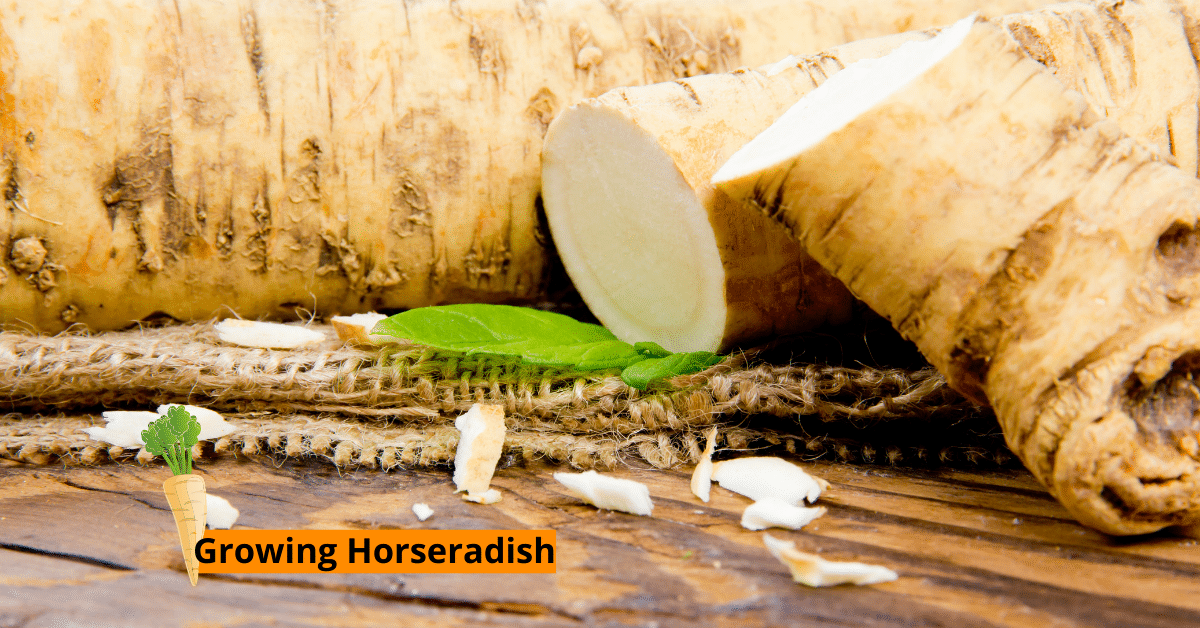Planting, Growing, and Harvesting Horseradish
Growing horseradish, A perennial plant is what a Horseradish plant is. It belongs to the family of Brassicaceae. Across the world, it is grown as a spice and a condiment. It is typically a root vegetable. Horseradish is mainly native to the southeastern parts of Europe and western parts of Asia. It is the tapered Horseradishroots for which the plant gets cultivated.
The flowers come in four petals, providing a great scent, and get borne in panicles. When the plants get established, extensive patches can get formed. The Horseradish roots that remain intact tend to provide a slight aroma. While growing Horseradish plants, they should not get exposed to the air. It might lose its zest and color.
Biological Name
Armoracia rusticana
Plant Type
Horseradish is a perennial plant.
Maturity Period
Horseradish can spread readily. After 140 to 160 days of planting, they become ready for harvests.
Maturity Size
At the time of maturity, they stand 12 to 18 inches tall
Soil Type
Horseradish prefers soil ranging from being slightly acidic to neutral.
Soil pH
It needs to be within 6.0 to 7.5 pH.
Exposure
The plant requires no shade to part sun.
Hardiness (USDA Zone)
3 to 9 USDA.
Spacing
The spacing must be 30 inches apart.
Bloom Time
The best time would be after the fall, or in winter, or by early spring.
Toxity
It contains mustard oil. It can be toxic at times.
Flower Color
It is pale off-white, which has a green undertone.
Growth Rate
Within 160 days, it proliferates.
Native Zone
It is native to southeastern Europe and western Asia.
Maintenance
Horseradish should get planted in areas far away from the other plants. Experts suggest controlling spread; the best way is for the horseradish to grow in containers.
History
Horseradish plantation has been with humankind for several centuries. It was the Egyptians that cultivated the plant back in the 15th century BC.
The Romans made use of horseradish as an aphrodisiac. The elderly made use of it to treat coughs and colds.
As a member of the Brassicaceae family, horseradish finds close relation to that of Brussels sprouts and kale. The sinus-clearing punch comes from volatile oil that the roots of horseradish release.
It generally appears when the root is grated or crushed. From the very beginning, people tend to reap the benefits of horseradish plantation. Vitamin C, potassium, and magnesium are some of the vital vitamins and minerals that it provides.
Nutritional Facts About Horseradish
Size of the portion: 1 teaspoon or 5 grams
- Calories: 2.4
- Total fats: 0 grams, 0%
- Sodium: 21miligrams, 1%
- Total carbohydrates: 0.6 grams, 0%
- Dietary fiber: 0.2 grams, 1%
- Sugar: 0.4 grams
- Protein: 0.1 grams, 0%
- Vitamin D: 0 mcg, 0%
- Calcium: 2.8 milligrams, 0%
- Iron: 0.02 milligrams, 0%
- Potassium: 12 milligrams, 0%
Research finds that horseradish contains an antibacterial component. Allyl isothiocyanate is the name of the element. Harmful bacteria get killed with the help of it.
It is resistant to the action of various microbes that can cause infections. Moreover, horseradish is effective when it comes to treating urinary tract infections.
Blood circulation receives a significant boost with the nutrients that horseradish provides. In case of a cold or sinus, there can be no better treatment than that of horseradish. The greater sulfur levels tend to clear the mucus.
The presence of the bio compounds helps to improve facial circulation and improve drainage.
Nutrients and Minerals for Horseradish
For planting horseradish, the roots need to get spread out. When one digs the hole deep enough, it allows the roots to expand with ease. The topsoil plays a vital part.
Horseradish uses organic materials, like grass clippings, for their perfect growth. The grass tends to break down to add nutrients to the soil.
With the addition of compost, manure, and peat moss, the growth receives acceleration. Such additions make the soil better. Organic materials tend to improve the moisture retention capabilities of the ground.
When to Plant Horseradish
The best practice suggests that growing horseradish requires cutting of the roots and the plant. Seeds may not be available at all times. But, sources are available at the nurseries.
The cuttings need to grow during spring or after the falls. One has to loosen the soil by 12 inches and add a layer of compost.
If one shows enough love for horseradish, he has to keep the spacing up to 30 inches.
Where to Plant Horseradish
Horseradish can adapt to different conditions and are tough plants. It produces the best roots when they get provided with the best care and the proper growing conditions.
Growing horseradish in containers requires an area full of sunlight. Partial sunlight may not provide the best of yields.
The soil needs tilling by 8 to 10 inches. Any roots or rocks found should get removed. Otherwise, it may impede the growth of the plant.
Horseradish plantations should get carried out in places, which are away from other crops. The spread must get checked.
How to plant horseradish:
When the purpose is planting horseradish, we can grow it from horseradish plants for horseradish roots. We must cultivate the cuttings in spring or fall.
Cut one-third of horseradish root for cooking purposes; we can use the button part for planting. Add some compost in 12 inches deep soil.
The horseradish root must be at a 45-degree angle two inches below the soil.
We can use horseradish root for planting. Growing horseradish from the source, we must plant horseradish roots 12 inches apart into 6 to 8 inches deep holes at the soil line at the crown of the core at a 45-degree angle.
With 6 to 8 inches of soil cover the hole, and we must water them sufficiently.
We can grow horseradish by planting horseradish seeds. We must sow horseradish seeds in deep well-cultivated soil, 5mm deep. It generally takes 7 to 15 days for the seeds to sprout.
To grom horseradish in a container, we should put it indoors. And then follow the same rules of planting elaborated before.
Horseradish Care:
Generally, horseradish thrives in soil that is rich and fast drained. Put Horseradish plant in a place where it can get full Sun. Experts advise not to plant horseradish in deep shade or wet soil.
Horseradish can endure all conditions. Plant horseradish away from other plants since it spreads very quickly.
Horseradish can endure various ranges of Sun exposure. But the ideal condition for it is no shade or slight shade.
Soil pH that varies from 6 to 7.5 and is slightly acidic to neutral, horseradish thrive in this kind of soil. To grow more roots, rich soil full of organic matter is what horseradish requires.
To get better quality of root, we should water the soil regularly.
The weather that suits horseradish most is cool. Fertilize the soil every three to four times a week. You can use compost or commercial 10-10-10 vegetable fertilizer.
Varieties of Horseradish:
- MarinerKren: we can identify this kind of horse lady from crinkled and broad leaves. Mariner Kren is ideal for home gardeners who prefer to grow few plants since this variety is prone to diseases, so commercial growers avoid this type.
- Bohemian type: the root of this kind of horseradish have fleshy roots. Bohemian-type horse ladies are also very resistant to diseases. We can identify this type of horseradish by leaves, which are smooth and tapered at the base.
- Big top western: this kind of horseradish is very resistant to diseases, especially the tunic mosaic one virus. Horseradish leaves are smooth and wide. The roots are generally rough and medium size. Researchers and farmers generally preferred this type more than home gardeners.
- Variegata: the foliage of this horseradish is beautiful, and it emerged from the center of the plant. Due to its beautiful nature, it is generally grown for beauty. After two to three years of planting the roots, this plant shows such a stunning leaves display.
- Wasabi: this kind of horseradish is native to Japan. Experts describe it taste as hot and sweet.
The above-ground stem is more responsible for this taste than the root section.
Cultivators find it challenging to cultivate wasabi outside japan.
Harvesting and Storing Horseradish:
The zing in horseradish roots comes from compounds; to form this compound, we need excellent soil.
Experts recommend harvesting horseradish during fall, winter, or spring. Some prefer to have it in early October due to its warming effects.
Harvesting horseradish root is a simple process. Along one side of the road, we must Dig an of the foot or two long trench. Lose the roots with a shovel or fork and dig the horseradish from the other side of the row.
We must be gentle while tugging it out by grasping the horseradish leaves.
Cut the rest and leave only an inch in the soil. Get rid of the side and bottom roots. The horseradish roots are longer than eight inches; we can replant it as following years stock.
Suppose we plan for harvesting horseradish in winter, dry, and wash the stock. In a perforated plastic bag, store the root for two months or even longer. It is a choice; we can do this or use it immediately.
When we want to use it as a condiment, we should wash and peel the roots. Cut the hearts in half and put the puree in a blender. Put crushed ice and water for better results.
We should avoid horseradish in summer; the most significant development in horseradish is during summer. To have a better result, harvest horseradish during late October.
Pest and diseases of horseradish:
To some limit, horseradish can endure damage to its leaves by pests, not affecting the quality of its roots. The insects that generally infects horseradish is flea beetles, caterpillars, false cinch bug and diamondback larvae. Cultivators are usually more worried about pests that harm horseradish roots.
Diseases that affect horseradish is bacterial leaf spot, cause bacteria. Infections due to fungus include brittle root, Cercospora leaf spot, ramularia leaf spot, and white rust.
Recipes:
- Horseradish vinaigrette.
- Salmon with potatoes and horseradish sauce
- Horseradish mashed potatoes.
Where is the best place to grow horseradish?
Plant the roots in loamy and moist soil where Ph varies from acidic to neutral.
How long does horseradish take to grow?
The leaves of horseradish generally sprout in spring when we plant them in late summer.
Does horseradish plant spread?
Horseradish plants spread so fast that they can harm the growth of other plants.
How do you know when horseradish is ready to harvest?
Exactly one year after planting, we should harvest it, that is late October.
Does horseradish have any health benefits?
Even studies suggest that horseradish can prevent colon, stomach cancer.
Does horseradish grow back?
Bugs can attack horseradish during this season, so it is better to do it before bugs infest it.

